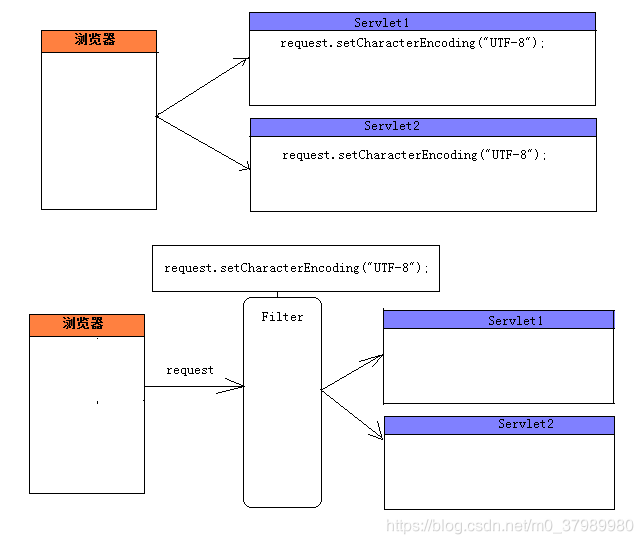Filter案例——请求编码、登录检查、敏感字过滤器
目录
- 案例1:请求编码过滤器
- 案例2:登录检查过滤器
- 案例3:敏感字过滤器
请求编码过滤器
- login.jsp
<%@ page contentType="text/html;charset=UTF-8" language="java" %>
<html>
<head>
<title>登录title>
head>
<body>
<form action="/filter_listener/loginServlet" method="post">
账号:<input type="text" name="username"><br>
密码:<input type="text" name="password"><br>
<input type="submit" value=" 登录 ">
form>
body>
html>
- LoginServlet.java
@WebServlet("/loginServlet")
public class LoginServlet extends HttpServlet {
protected void doPost(HttpServletRequest request, HttpServletResponse response) throws ServletException, IOException {
// 无论什么Servlet往浏览器中输入字符时都要设置编码.
// 将这两行代码设置到过滤器中
// request.setCharacterEncoding("utf-8");
// response.setContentType("text/html;charset=utf-8");
// ================================================
String username = request.getParameter("username");
String password = request.getParameter("password");
System.out.println(username + "," + password);
}
protected void doGet(HttpServletRequest request, HttpServletResponse response) throws ServletException, IOException {
this.doPost(request, response);
}
}
- CharacterEncodingFilter.java
@WebFilter(value = "/*", initParams = {
@WebInitParam(name = "encoding", value = "UTF-8")
})
public class CharacterEncodingFilter implements Filter {
private String encoding;
public void doFilter(ServletRequest req, ServletResponse resp, FilterChain chain) throws ServletException, IOException {
// 设置编码
//1. 应用中没有编码并且自己设置了编码
if (hasLength(encoding) && req.getCharacterEncoding() == null) {
req.setCharacterEncoding(encoding);
}
chain.doFilter(req, resp); // 放行
}
public void init(FilterConfig config) throws ServletException {
this.encoding = config.getInitParameter("encoding");
}
private boolean hasLength(String str) {
return str != null && !"".equals(str.trim());
}
public void destroy() {
}
}
登录检查过滤器
- jsp
在welcome.jsp, function1.jsp, function2.jsp, function3.jsp有重复代码.可以使用过滤器来设置.
<%@ page contentType="text/html;charset=UTF-8" language="java" %>
<html>
<head>
<title>登录title>
head>
<body>
<form action="/filter_listener/loginServlet2" method="post">
账号:<input type="text" name="username" required><br>
密码:<input type="text" name="password"><br>
<input type="submit" value=" 登录 ">
form>
body>
html>
<%@ page contentType="text/html;charset=UTF-8" language="java" %>
${sessionScope.USER_IN_SESSION}
<%--<%--%>
<%-- Object user = session.getAttribute("USER_IN_SESSION");--%>
<%-- // 如果user没有登录--%>
<%-- if (user == null){--%>
<%-- response.sendRedirect(request.getContextPath()+"/checkLogin/login.jsp");--%>
<%-- }--%>
<%--%>--%>
<hr>
<a href="${pageContext.request.contextPath}/checkLogin/function1.jsp">功能1a>
<a href="${pageContext.request.contextPath}/checkLogin/function2.jsp">功能2a>
<a href="${pageContext.request.contextPath}/checkLogin/function3.jsp">功能3a>
<%@ page contentType="text/html;charset=UTF-8" language="java" %>
${sessionScope.USER_IN_SESSION}
<%--<%--%>
<%-- Object user = session.getAttribute("USER_IN_SESSION");--%>
<%-- // 如果user没有登录--%>
<%-- if (user == null){--%>
<%-- response.sendRedirect(request.getContextPath()+"/checkLogin/login.jsp");--%>
<%-- }--%>
<%--%>--%>
这是功能1
<%@ page contentType="text/html;charset=UTF-8" language="java" %>
${sessionScope.USER_IN_SESSION}
<%--<%--%>
<%-- Object user = session.getAttribute("USER_IN_SESSION");--%>
<%-- // 如果user没有登录--%>
<%-- if (user == null){--%>
<%-- response.sendRedirect(request.getContextPath()+"/checkLogin/login.jsp");--%>
<%-- }--%>
<%--%>--%>
这是功能2
<%@ page contentType="text/html;charset=UTF-8" language="java" %>
${sessionScope.USER_IN_SESSION}
<%--<%--%>
<%-- Object user = session.getAttribute("USER_IN_SESSION");--%>
<%-- // 如果user没有登录--%>
<%-- if (user == null){--%>
<%-- response.sendRedirect(request.getContextPath()+"/checkLogin/login.jsp");--%>
<%-- }--%>
<%--%>--%>
这是功能3
- LoginServlet.java
@WebServlet("/loginServlet2")
public class LoginServlet2 extends HttpServlet {
protected void doPost(HttpServletRequest request, HttpServletResponse response) throws ServletException, IOException {
String username = request.getParameter("username");
// 把登录信息存储到session中
request.getSession().setAttribute("USER_IN_SESSION", username);
response.sendRedirect(request.getContextPath()+"/checkLogin/welcome.jsp");
}
protected void doGet(HttpServletRequest request, HttpServletResponse response) throws ServletException, IOException {
this.doPost(request, response);
}
}
- CheckLoginFilter
@WebFilter("/*")
public class CheckLoginFilter implements Filter {
// 不需要检查的资源
private String[] unCheckUris = {"/filter_listener/checkLogin/login.jsp",
"/filter_listener/checkLogin/login",
"/filter_listener/loginServlet2"};
public void doFilter(ServletRequest req, ServletResponse resp, FilterChain chain) throws ServletException, IOException {
HttpServletRequest request = (HttpServletRequest) req;
HttpServletResponse response = (HttpServletResponse) resp;
// ================================================================================
// 会产生请求死循环.因为/*,过滤器可以拦截任何请求
/*
if (user == null) {// 没有登录
Object user = request.getSession().getAttribute("USER_IN_SESSION");
response.sendRedirect(request.getContextPath() + "/checkLogin/login.jsp");
return;
}
*/
// 当前正在过滤的资源
String requestURI = request.getRequestURI();
// System.out.println(requestURI);
//if (!"/filter_listener/checkLogin/login.jsp".equals(requestURI) && !"/filter_listener/checkLogin/login".equals(requestURI)) {
// 优化写法
if (!Arrays.asList(unCheckUris).contains(requestURI)) {
Object user = request.getSession().getAttribute("USER_IN_SESSION");
//System.out.println(user);
if (user == null) { // 没有登录
response.sendRedirect(request.getContextPath() + "/checkLogin/login.jsp");
return;
}
}
//==========================================================================================
chain.doFilter(request, response);
}
public void init(FilterConfig config) throws ServletException {
}
public void destroy() {
}
}
敏感字过滤器
跳转到目录
案例2_敏感词汇过滤
* 需求:
1. 对day17_case案例录入的数据进行敏感词汇过滤
2. 敏感词汇参考《敏感词汇.txt》
3. 如果是敏感词汇,替换为 ***
* 分析:
1. 对request对象进行增强。增强获取参数相关方法
2. 放行。传递代理对象
* 增强对象的功能:
* 设计模式:一些通用的解决固定问题的方式
1. 装饰模式
2. 代理模式
* 概念:<卖电脑>
1. 真实对象:被代理的对象(联想公司) 真实对象被代理对象所代理
2. 代理对象:卖联想电脑代理商
3. 代理模式:代理对象代理真实对象,达到增强真实对象功能的目的
* 实现方式:
1. 静态代理:有一个类文件描述代理模式(会有一个代理类文件)
2. 动态代理:在内存中形成代理类(在内存中有代理类)
* 实现步骤:
1. 代理对象和真实对象实现相同的接口
2. 代理对象 = Proxy.newProxyInstance(); // 创建代理对象
3. 使用代理对象调用方法。
4. 增强方法
* 增强方式:
1. 增强参数列表
2. 增强返回值类型
3. 增强方法体执行逻辑
卖联想电脑- 代理设计模式
- Lenovo.java
/**
* 真实类
*/
public class Lenovo implements SaleComputer {
@Override
public String sale(double money) {
System.out.println("卖了一台"+money+"元的联想电脑");
return "联想电脑";
}
@Override
public void show() {
System.out.println("展示电脑");
}
}
- SaleComputer.java
public interface SaleComputer {
public String sale(double money);
public void show();
}
- ProxyTest.java
public class ProxyTest {
public static void main(String[] args) {
//1. 创建真实对象
Lenovo lenovo = new Lenovo();
//2. 动态代理增强lenovo对象
/*
三个参数:
1. 类加载器:真实对象.getClass().getClassLoader()
2. 接口数组:真实对象.getClass().getInterfaces()
3. 处理器:new InvocationHandler()
*/
SaleComputer proxy_lenovo = (SaleComputer) Proxy.newProxyInstance(lenovo.getClass().getClassLoader(),
lenovo.getClass().getInterfaces(),
new InvocationHandler() {
/**
* 代理逻辑编写的方法,代理对象调用的所有方法都会触发该方法执行.
* 参数:
* 1. proxy:代理对象
* 2. method:代理对象调用的方法,被封装为的对象
* 3. args:代理对象调用的方法时,传递的实际参数
*/
@Override
public Object invoke(Object proxy, Method method, Object[] args) throws Throwable {
/*System.out.println("该方法执行了....");
System.out.println(method.getName());
System.out.println(args[0]);*/
//判断是否是sale方法
if (method.getName().equals("sale")) {
//1.增强参数
double money = (double) args[0];
money = money * 0.85;
//2. 增强方法体
System.out.println("专车接你....");
//使用真实对象调用该方法
String obj = (String) method.invoke(lenovo, money);
System.out.println("免费送货...");
//3.增强返回值
return obj + "_鼠标垫";
} else {
Object obj = method.invoke(lenovo, args);
return obj;
}
}
});
//2. 调用出售电脑的方法
String computer = proxy_lenovo.sale(8000);
System.out.println(computer);
// proxy_lenovo.show();
}
}
敏感字过滤实现:
- TestSensitiveWordsServlet.java
@WebServlet("/testSensitiveWordsServlet")
public class TestSensitiveWordsServlet extends HttpServlet {
protected void doPost(HttpServletRequest request, HttpServletResponse response) throws ServletException, IOException {
String username = request.getParameter("username");
String msg = request.getParameter("msg");
System.out.println(username + "," + msg);
}
protected void doGet(HttpServletRequest request, HttpServletResponse response) throws ServletException, IOException {
this.doPost(request, response);
}
}
- SensitiveWordsFilter.java
/**
* 敏感词汇过滤器
*/
@WebFilter("/*")
public class SensitiveWordsFilter implements Filter {
// 存储敏感词汇的集合
private List<String> list = new ArrayList<>();
public void doFilter(ServletRequest req, ServletResponse resp, FilterChain chain) throws ServletException, IOException {
//1. 创建代理对象,增强getParameter方法
ServletRequest proxy_req = (ServletRequest) Proxy.newProxyInstance(req.getClass().getClassLoader(), req.getClass().getInterfaces(), new InvocationHandler() {
@Override
public Object invoke(Object proxy, Method method, Object[] args) throws Throwable {
// 增强getParameter方法
// 判断是否是getParameter方法
if (method.getName().equals("getParameter")) {
// 增强返回值
// 获取返回值
String value = (String) method.invoke(req, args);
if (value != null) {
for (String str : list) {
if (value.contains(str)){
value = value.replaceAll(str, "***");
}
}
}
return value;
}
return method.invoke(req, args);
}
});
//2. 放行
chain.doFilter(proxy_req, resp);
}
public void init(FilterConfig config) throws ServletException {
try {
//1. 获取文件真实路径
ServletContext servletContext = config.getServletContext();
String realPath = servletContext.getRealPath("/WEB-INF/classes/敏感词汇.txt");
//2. 读取文件
BufferedReader br = new BufferedReader(new FileReader(realPath));
//3. 将文件的每一行数据添加到list集合中
String line = null;
while ((line = br.readLine()) != null){
list.add(line);
}
br.close();
System.out.println(list);
} catch (Exception e) {
e.printStackTrace();
}
}
public void destroy() {
}
}

